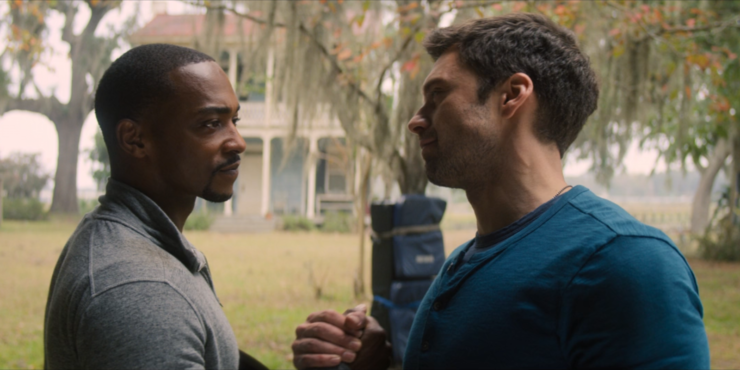When I saw that the title of the fifth episode of The Falcon and the Winter Soldier was going to be “Truth,” I may have fist-pumped a bit. That was the title of the 2003 comic book miniseries by Robert Morales & Kyle Baker that introduced Isaiah Bradley, subtitled Red, White, and Black, and I was hoping that we’d see more of Carl Lumbly’s MCU version of Bradley. I was not disappointed, as the scene with him and Sam Wilson was one of several excellent scenes in this take-a-breath episode that paused from the fight scenes to remind us of some of the themes that were introduced in the first couple of episodes that had fallen a bit by the wayside.
Let’s start with the least interesting part of the episode, which is the fallout from John Walker committing a murder in the middle of a public square. Not to say that isn’t interesting, but it’s less so than everything else that happens. Walker wanders off after his murder, muttering to himself. He’s stopped by Bucky Barnes and Sam in The Obligatory Action Scene at the top of the episode, with Nico’s blood still staining his shield. Falcon’s wings are trashed, but in the end, Walker is defeated, and Sam leaves with the shield.
For Walker’s part, he has his cufflinks snipped off, as it were, and is not only stripped of the title of Captain America, but also given an other than honorable discharge. While not as bad as a dishonorable discharge, it does cost him his rank and his pension, which is pretty harsh for a guy who’s won three medals of honor—and also not nearly harsh enough for a guy who committed murder. It’s an understandable decision by the committee, as it saves them the embarrassment of court-martialing and imprisoning their new Cap, but it also leaves him free. The final post-credits scene of the episode is Walker creating his own new shield…
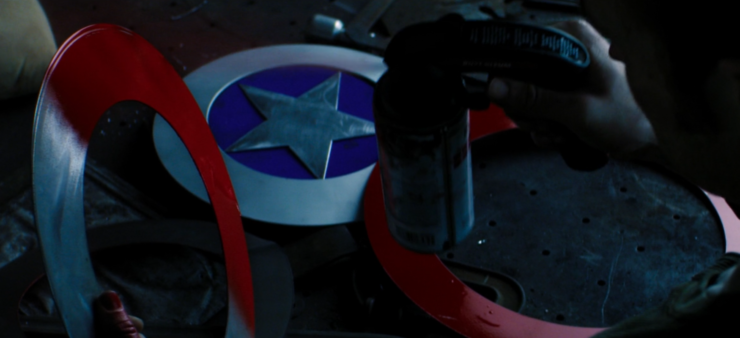
Prior to that, we see him visiting Lemar Hoskins’ parents, and he lies to them, and says the guy he murdered was the one who killed Lemar. (It was, in fact, Karli Morgenthau, as we’re reminded in the “previously on” segment.) What’s not at all clear is if the lie is also to himself. Walker is pretty clearly unhinged, between his mouthing off at the committee and his crazed rantings while fighting Sam and Bucky, but is it because of Lemar’s death? Is it because he took the Super Soldier Serum? (And even if it wasn’t obvious from how he was more than holding his own against Sam and Bucky, we’re explicitly told he took the serum this week.) Is it having an adverse effect on his sanity?
To bolster that last argument, we have Sam visiting Isaiah and getting his whole story. He was one of several African-American soldiers they experimented on after World War II to try to duplicate Dr. Erskine’s work. Isaiah was the only one who survived, and he also disobeyed orders so he could rescue his fellow soldiers. Sam comes to him while carrying the shield in a case to try to figure out what he should do with it, and Isaiah’s considered opinion is that no self-respecting black man should carry it. More to the point, he knows damn well that the government would never allow it—they want their blond-haired, blue-eyed Avenger like Steve Rogers or John Walker. They erased Isaiah’s existence, even though he fought for his country just like Rogers and Walker did.
But the serum didn’t work the same on all the black soldiers—Isaiah was the only it really took for without major side effects, and they experimented on him quite a bit to try to find out why. It’s possible that we’re seeing those side effects in Walker—and in the Flag Smashers.
As for Sam, he has a decision to make. Does he listen to Isaiah? Or does he do what Steve asked him to do?
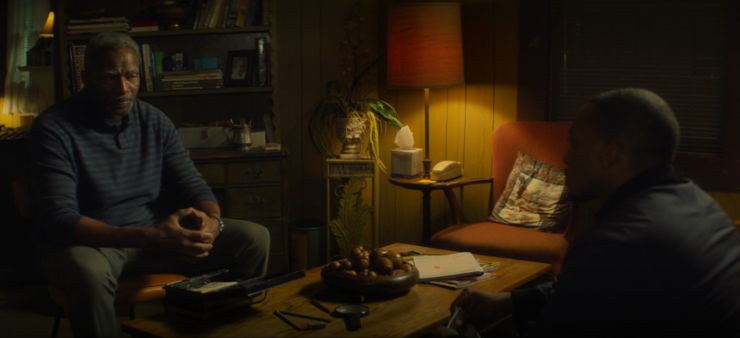
Back in July of 2019, when Marvel Studios announced their Phase 4 plans, I wrote the following on this very web site: “Why is The Falcon and the Winter Soldier still being called that when Sam Wilson is Captain America now? Seriously, calling it that when you first announced it is necessary due to not wanting to spoil Endgame, but now we know that the Falcon is the new Cap. So why isn’t this being called Captain America and the Winter Soldier? Particularly now, it’s important to acknowledge that the symbol of the U.S. is currently an African American.”
My opinion in the last sentence of that quote hasn’t changed—in fact, I feel even more strongly about it given the appalling number of incidents involving African-American citizens being targeted and killed by law-enforcement that keep fucking happening (not to mention increased vitriol directed at Asian Americans)—but I also get what they’re doing here. The history of people who aren’t white in this country is awful, and while things are better now than they were in the past, they’re still not by any stretch of the imagination good. The question for Sam is whether or not he will embody the ideals of America, which are often at odds with the reality of America—or will he be seen as capitulating to that reality in defiance of those ideals?
It’s not an easy question to answer, especially given how many parts of the world see America: as imperialist and stomping all over everything and very much my-way-or-the-highway. That particular perception of America is reinforced by Walker’s behavior.
Sam thinks about this while going back home and helping his sister Sarah fix up the family boat in order to be able to sell it. Right now, it’s in such awful shape they can’t even sell it—but Sarah can’t afford to fix it, either.
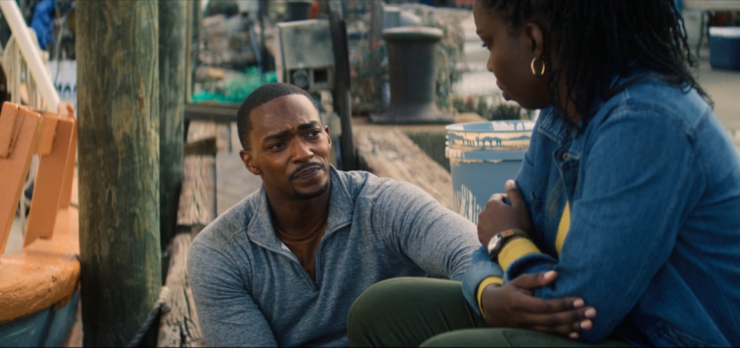
Sarah also sends her two sons off with extra food to give to two of their classmates, whose father doesn’t get up early enough to prepare their lunch, and who are too proud to ask for help—so Sarah gives it to them, just like their mother did. And that inspires Sam, because the Wilson family has always given to the community, and now it’s time to call in those favors. Sure enough, people are willing to help out if you aren’t too proud to ask.
As much as the ass-covering of the committee that strips Walker of his Captain America-hood represents America, so also does what happens with the Wilsons. I saw it here in New York after the Twin Towers were destroyed, and again last year when the pandemic struck: in times of trouble, communities band together and help out. Especially communities that aren’t getting any help from outside.
Though there is one bit of outside help: Bucky shows up with a gift from Wakanda. The implication is that it’s a new set of wings, but while the episode ends with Sam opening the case, we aren’t going to see its contents until next Friday. But I’m fairly certain, since Bucky specifically asked Ayo for this gift, that it’s a version of the wings that is bedecked in red, white, and blue (much like the outfit Sam wore in the comics when he took over as Captain America).
Bucky asked for this after the Dora Milaje took Zemo away. Some may view the resolution of Zemo’s storyline as anticlimactic, but it actually makes perfect sense. Bucky and the Dora Milaje track Zemo down to the Sovokia memorial and take him in peacefully (though Bucky holds a gun to his head and fires, only afterward revealing that it was empty, mostly to show that he’s not a killer anymore). There was no other way for this to go. Zemo isn’t super-powered, and he can’t stand up to any one of the Dora Milaje or to Bucky, and while he might think he can still manipulate the latter, he’s helpless against the former. If he fights back, he’s dead meat; if he keeps running, the Dora Milaje won’t rest until he’s caught and he’ll be on the run, taxing his resources, forever; if he surrenders, he’s put in prison, and he can survive that. I honestly don’t get why more bad guys in fiction don’t do what Zemo does here…
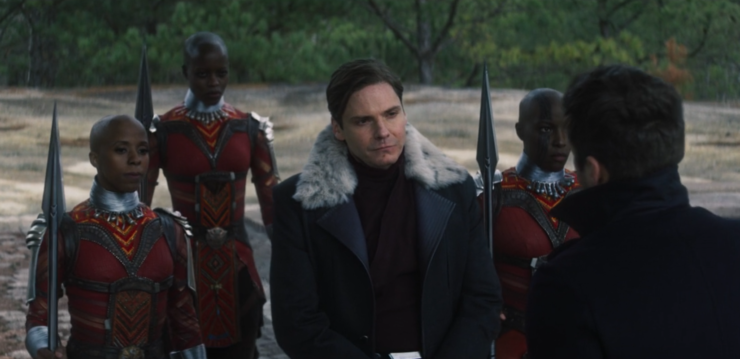
In addition, Bucky works with Sam on how to use the shield as a frisbee, and Sam returns the favor by once again playing counselor. Bucky’s method of making amends is attempting to give himself closure, but it isn’t working. What he needs to do is find a way to give his victims that he’s making amends to closure. Sam tells him to start with just one person, and it’s pretty obvious that it’s going to be the father of the innocent bystander he killed that we met back in the first episode. Especially since that guy is in New York, and that’s where the action will be next time.
We know that because the Flag Smashers’ next target is the Global Repatriation Council, which is headquartered in New York, and is in the midst of talks about a ruling involving refugees that is interrupted by a power outage caused by the Flag Smashers. The episode ends with that attack, with Sam being told by Torres that the Flag Smashers are in the Big Apple, with Bucky on a course to be back in NYC, and with Walker putting a new shield together.
All this sets up a slam-bang finale quite nicely. With the obvious exception of the opening fight among Sam, Bucky, and Walker, this is a very quiet, reflective episode, and it’s welcome. This is the type of thing that the movies don’t always have time for, and it’s good to see Marvel Studios taking advantage of the longer running time of a six-episode (or whatever) season to give the characters a chance to breathe and grow and think. I’m also really glad to see the themes of racism and family and community and friendship and moving on with your life back in the forefront, as it was mostly absent from the last couple of episodes.
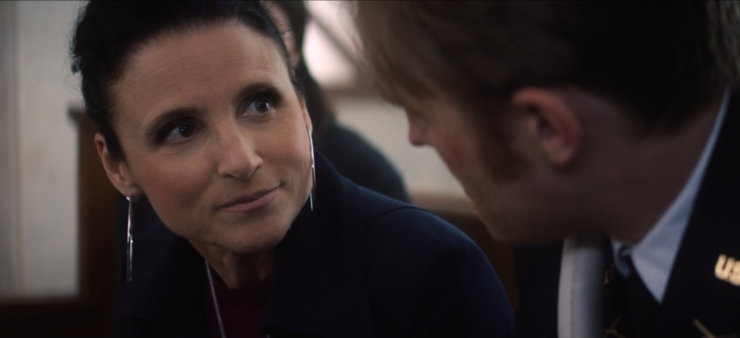
Odds and ends
- Julia Louis-Dreyfuss shows up out of nowhere as Contessa Valentina Allegra de Fontaine, who is the latest candidate to be the Power Broker, though she’s not identified as such. In the comics, Fontaine was an agent of S.H.I.E.L.D. created by Jim Steranko on his historic run doing Nick Fury, Agent of S.H.I.E.L.D. stories in Strange Tales in the 1960s. In addition to being a top agent, she was also Fury’s love interest. More recently, in the Secret Warriors series written by Brian Michael Bendis and Jonathan Hickman, she was revealed to be a Russian sleeper agent, and she eventually turned herself in. (This irritated me, as Val was one of the few characters of Italian descent in the Marvel Universe who wasn’t a mobster or a psychopath or comic relief, and to have her be turned into a bad guy pissed me off something fierce. The character hasn’t been seen in the comics for over a decade, though I’m hoping her use here might inspire a comics creator to bring her back.) Who she’s supposed to be in the MCU is still up in the air. The business card she leaves with Walker is blank.
- The theory that Sharon Carter is the Power Broker took a big hit, though her status as a friendly character is even more up in the air. We see her on the phone with a job for Georges Batroc, and then we see Batroc providing arms and aid and comfort to the Flag Smashers right before they attack the GRC. Batroc specifically wants to get back at the Falcon for screwing up his deal in the first episode, and Carter is the one who sent him on this particular mission of vengeance. Plus it’s unlikely that Carter would be helping the Flag Smashers if she was the Power Broker, since the PB has been after the Flag Smashers all along. Curiouser and curiouser…
- The story Isaiah tells Sam about his own history tracks pretty closely to the story told in Truth: Red, White, and Black, which is fabulous.
- However, I am more than a little peeved at how the billing works here. For some reason, Georges St-Pierre gets “opening” credits billing as Batroc, yet Carl Lumbly is reduced to just being listed with the rest of the cast in tiny print in the closing credits for his much more important role as Isaiah. I realize this probably mostly just means that St-Pierre has a better agent, but Lumbly—a superb actor who has had a spectacular career both in front of the camera and as a voice actor (among other things, he was J’onn J’onzz in the turn-of-the-millennium Justice League animated series)—deserves better billing.
- The scene where Walker is ousted by the committee is a fun-house-mirror version of Steve Rogers appearing before the Commission in Captain America #332 by Mark Gruenwald & Tom Morgan in 1987, which ended with Rogers turning in the uniform and shield and renouncing the title of Captain America.
- The Falcon didn’t have wings in the comics, initially, he was just a good hand-to-hand combatant and athlete. The wings he did get were a gift from the Black Panther in Captain America #170 by Steve Englehart, Mike Friedrich, & Sal Buscema in 1974. The MCU goes that route in this episode, as Walker trashes the wings Sam had been using, and Bucky asks Ayo to have Shuri (I assume it’s Shuri, because duh) make Sam a new set of wings.
- THERE’S A TRAINING MONTAGE! Okay, as a martial artist of more than fifteen years’ standing, I intellectually understand that training montages are stupid and misleading and give you the impression that you can become super-duper-awesome in a ridiculously short time. (In my karate discipline, it’s a minimum of five years before you can be considered for a black belt promotion, and it’s only that short if you train several days a week for all five of those years.) But as a child of the 1980s, I LOVE THAT THERE’S A TRAINING MONTAGE. Especially because Anthony Mackie plays it so well, showing both his dedication and especially his frustration at not being able to catch the shield when he throws it around frisbee-like.
Keith R.A. DeCandido also does the Star Trek: Voyager Rewatch every Monday and Thursday. His takes on the MCU films can be found in his “4-Color to 35-Millimeter: The Great Superhero Movie Rewatch” that started on this site in 2017.










